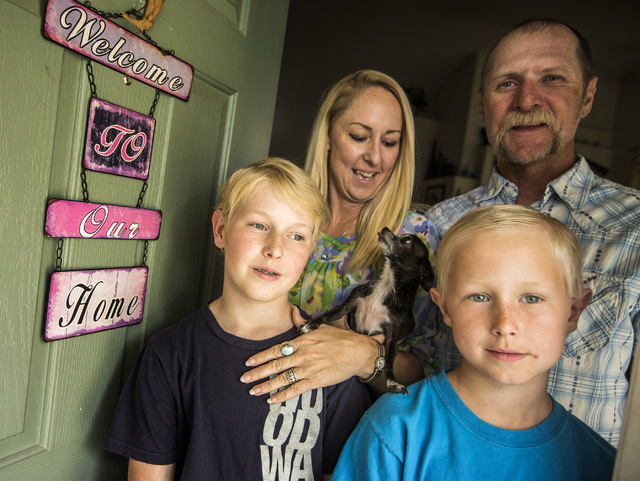
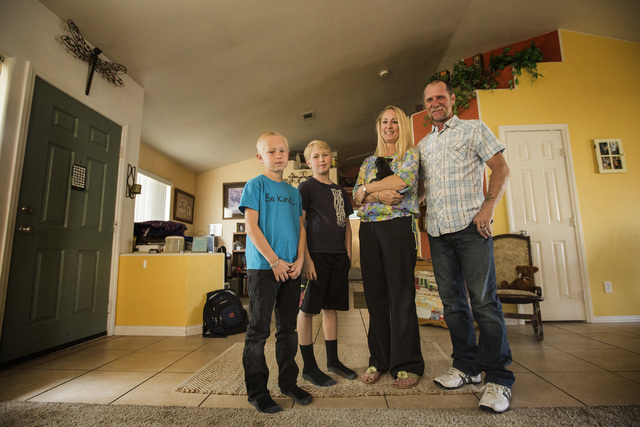
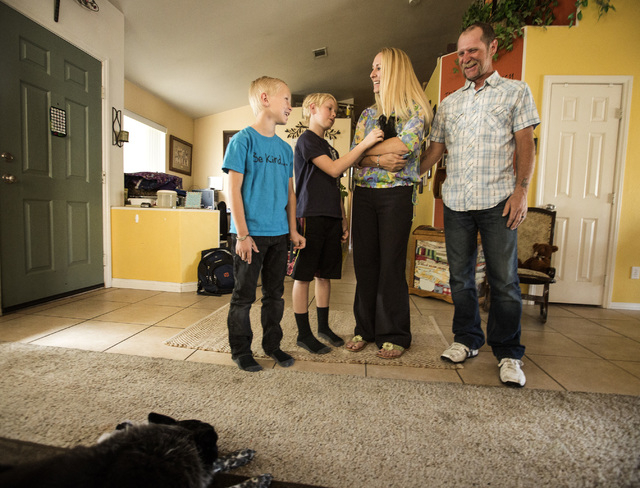
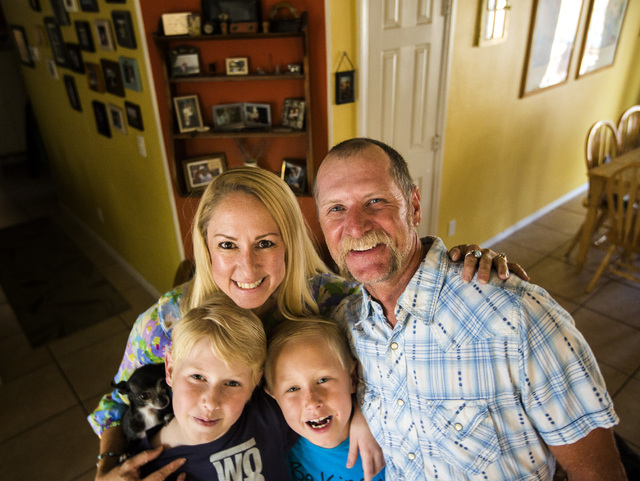
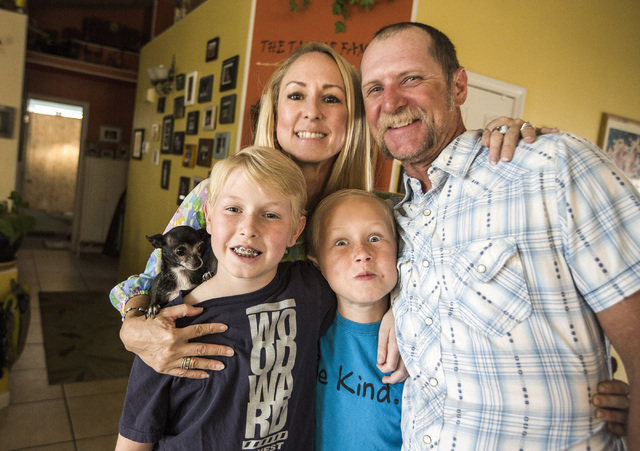
When ironworker Shawn Taylor began in his craft more than 20 years ago, Southern Nevada was heading for record numbers in building and construction employment gains.
“From ’92 or ’94, all the way through 2008, I’d never been laid off one time,” Taylor said.
But the Great Recession brought with it a drought in the construction industry, leaving Taylor and his wife, Molly, to lose grip on the life that they had built for themselves and their two sons, Dalton, 11, and Benjamin, 9.
Their story puts a human face on the roller-coaster ride that has been the construction industry in the Las Vegas valley over the past decade.
The slow down hit home in 2008 with operations at the planned 3,300-room Echelon project coming to a halt.
The announcement came suddenly: 800 men were told to stop working, Molly Taylor said.
Shawn Taylor was able to move down the road to the next project, Fontainebleau, but the family — and Las Vegas — hadn’t seen the end of hard times, just the beginning.
“He was working at Fontainebleau when it all stopped one day,” Molly Taylor said.
Her husband was one of 3,300 construction workers that were displaced in 2009 after the megaproject was halted over a funding dispute between Fontainebleau and its lenders.
“Everybody was shocked, absolutely shocked,” Molly Taylor said.
After the downturn began, their lives went on a downward path, going from an income of more than $80,000 a year to barely $20,000 during the course of the next few years.
Shawn Taylor had some protections in place for a rainy day. His years with the Ironworkers Union Local 433 had seeded some emergency funds they needed to get through. The union sets aside money when it agrees on a package price for a project, Molly Taylor said. The money is then slotted for pensions, health and welfare and annuities that workers can access if they run into trouble.
“If they hadn’t done that, we would have never saved that money,” Molly Taylor said.
Shawn Taylor agreed. “No, we probably would have lost our house and the vehicle and everything,” he said.
And that’s just what happened to some of his union brothers.
It was really sad, Molly Taylor said. Union iron worker brothers would call in tears because they were losing their homes or they didn’t have anywhere to go. Some were forced to move in with other iron worker families, Molly Taylor said.
The Taylors were faced with other challenges of their own as well.
Shawn Taylor’s mother died in 2009 after a long illness.
And Molly Taylor had to deal with her own illness the following year as she tried returning to the workforce.
“I did go back to work in 2010, and I passed out. They took my license,” Molly Taylor said.
The diagnosis wasn’t easy to come by either. “I went to doctor appointments nonstop trying to figure it out,” she said.
Three years later, she was diagnosed with reactive hypoglycemia — a condition that can bring the body’s blood sugar to unhealthy and dangerous levels.
The disease can be controlled by making dietary changes. But it was 2014 before she could go back to work. But by then, there were new challenges.
It seemed an eternity since thousands of workers built the pirate ships at Treasure Island, the Bellagio and City Center.
Money remained the central issue. During that time, they would lose most everything. They chewed through Shawn Taylor’s retirement fund and an inheritance from his mother’s estate.
“We managed to make it through with a roof over our head and our two vehicles and that’s it,” Molly Taylor said.
From 2008 to 2014, Shawn Taylor said he felt he couldn’t afford to travel in search of work.
“You got a get a hotel, and the gas to get there; it gets pretty expensive,” Shawn Taylor said. “We were barely able to pay our electric and power and mortgage and putting food on the table.”
But by 2014, Shawn Taylor left Las Vegas to seek work through other union halls across the country. He went to California, North Dakota and worked on the Tesla project in Reno. He said he was gone between seven and eight months.
The financial challenges of going out of state add up, but the family challenges can also be difficult.
“It’s really hard on the boys,” Molly Taylor said. “We’re a really close family. For dad to leave, it hurts.”
Traveling has been a way of life for many other union iron workers around the Valley.
Robert Conway, business agent for Ironworkers Local 433, estimated that 500 out of the 832 registered members in Southern Nevada were on the road working on the Tesla plant, the Intel plant in Sacramento, Calif., or other projects in the San Francisco area.
At the height of Southern Nevada’s building boom, Conway estimated 3,200 to 3,500 Local 433 iron workers. The 832 residents were outnumbered by about 2,500 workers who had come from out of state to work on projects in Nevada.
After the crash, that number would fizzle out, with between 110 and 120 Southern Nevada resident iron workers on a job today, Conway added.
Shawn Taylor is one of the lucky ones who found work in his own backyard at the new MGM arena project. Molly Taylor is also back to work in public relations.
But they know the situation is only temporary.
For iron workers like Shawn Taylor, their portion of the arena work is at an end and the Taylors are preparing for the possibility that some of the larger projects — such as Resorts World, the former Echelon project where the Taylors’ saga began — won’t be going yet.
For Shawn Taylor, the option of going to California to fill an employment gap could be a possibility.
Conway said the union has been in talks with the Genting Group on the future site of the planned $4 billion Resorts World project. There has been no labor agreement signed on the project to date, despite the groundbreaking in early May, Conway added.
Iron workers are watching some other large projects for signs work may be coming soon.
There’s talk that Jackie Robinson’s $1.4 billion dollar arena could start construction between fall and early winter. And a labor agreement has already been signed on it, Conway said.
Conway said there are other projects that are already on the move including the convention center at Mandalay Bay and at the Rock in Rio site.
But as far as future workforce needs into 2016, Conway could give no estimates.
Despite several projects on the horizon, there have been some losses around Nevada in construction as a whole. According to a report by the Associated General Contractors of America, Nevada lost 1,300 construction jobs from January to February, equaling a 2 percent decline.
Spring numbers look better. Nevada had the fourth highest percentage gains in construction employment from March to April, with a 3.4 percent rise, adding 2.200 construction jobs.
But AGC Chief Economist Ken Simonson said Nevada’s employment rate remains 51 percent below its June 2006 peak.
Simonson added that employers are having difficulty locating experienced workers in areas that were hit hard with continuous declines in the past.
Simonson said the long drought in construction work over most states lead many workers to find employment in other industries or retire.
And analysts from AGC also fear that more losses could be ahead if regulators can’t find a better way to fund public projects. AGC also noted a decline in residential projects.
Conway is also concerned with funding public projects.
“We’re trying to get some ballot initiative’s going in regards to indexing,” Conway said.
Regardless of how things go, Shawn Taylor and his family said they are here for the long haul.
“If we made it through what just happened the last seven years, then I think we can make it through anything,” Molly Taylor said.
“We just want to see our kids through high school,” she said. “Ben’s in third grade. If we can get Ben through high school, and we’re in this house, then we done good, then Vegas did us right, and it was worth staying and struggling and making it through if we can get our kids through school and still live here.”






